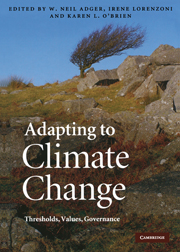Book contents
- Frontmatter
- Contents
- List of contributors
- Preface
- 1 Adaptation now
- Part I Adapting to thresholds in physical and ecological systems
- Part II The role of values and culture in adaptation
- Part III Governance, knowledge and technologies for adaptation
- 20 Whether our levers are long enough and the fulcrum strong? Exploring the soft underbelly of adaptation decisions and actions
- 21 Decentralized planning and climate adaptation: toward transparent governance
- 22 Climate adaptation, local institutions and rural livelihoods
- 23 Adaptive governance for a changing coastline: science, policy and publics in search of a sustainable future
- 24 Climate change, international cooperation and adaptation in transboundary water management
- 25 Decentralization: a window of opportunity for successful adaptation to climate change?
- 26 Adapting to climate change in Sámi reindeer herding: the nation-state as problem and solution
- 27 Limits to adaptation: analysing institutional constraints
- 28 Accessing diversification, networks and traditional resource management as adaptations to climate extremes
- 29 Governance limits to effective global financial support for adaptation
- 30 Organizational learning and governance in adaptation in urban development
- 31 Conclusions: Transforming the world
- Index
- References
26 - Adapting to climate change in Sámi reindeer herding: the nation-state as problem and solution
Published online by Cambridge University Press: 31 August 2009
- Frontmatter
- Contents
- List of contributors
- Preface
- 1 Adaptation now
- Part I Adapting to thresholds in physical and ecological systems
- Part II The role of values and culture in adaptation
- Part III Governance, knowledge and technologies for adaptation
- 20 Whether our levers are long enough and the fulcrum strong? Exploring the soft underbelly of adaptation decisions and actions
- 21 Decentralized planning and climate adaptation: toward transparent governance
- 22 Climate adaptation, local institutions and rural livelihoods
- 23 Adaptive governance for a changing coastline: science, policy and publics in search of a sustainable future
- 24 Climate change, international cooperation and adaptation in transboundary water management
- 25 Decentralization: a window of opportunity for successful adaptation to climate change?
- 26 Adapting to climate change in Sámi reindeer herding: the nation-state as problem and solution
- 27 Limits to adaptation: analysing institutional constraints
- 28 Accessing diversification, networks and traditional resource management as adaptations to climate extremes
- 29 Governance limits to effective global financial support for adaptation
- 30 Organizational learning and governance in adaptation in urban development
- 31 Conclusions: Transforming the world
- Index
- References
Summary
We have some knowledge about how to live in a changing environment. The term ‘stability’ is a foreign word in our language. Our search for adaptation strategies is therefore not connected to ‘stability’ in any form, but is instead focused on constant adaptation to changing conditions.
Johan Mathis Turi, Chairman of International Centre for Reindeer Husbandry (ICR), Tromsø, UN Environmental Day, June 2007Introduction
Climate change is likely to affect the Sámi regions in Norway, Sweden, Finland and Russia, with greater variability in temperature, precipitation and wind, and higher winter temperatures (ACIA, 2005; Tyler et al., 2007). These factors strongly affect snow quality and quantity, with snow quality as a crucial factor for reindeer herding. Considering their experience obtained through time and their traditional ecological knowledge, the pastoral practices of Sámi herders are inherently well suited to handle huge variations in climatic conditions. Reindeer herding and its natural environment have always been subject to large variability in weather patterns, and skilful adaptation to these past variations offers important insights on adaptation to climate change. In particular, it is crucial to recognize the importance of traditional ecological knowledge (Berkes, 2008).
The adaptation of Sámi reindeer herding to climate change is conditioned by its political and socio-economic environment (ACIA, 2005, p. 971; E. S. Reinert, 2006; Tyler et al., 2007). Important parts of the traditional adaptive strategies – the composition of herds and the flexibility to move reindeer herds between summer and winter pastures – are challenged by nation–state policies restricting herd diversity and mobility and by rigid regulations.
Information
- Type
- Chapter
- Information
- Adapting to Climate ChangeThresholds, Values, Governance, pp. 417 - 432Publisher: Cambridge University PressPrint publication year: 2009
References
Accessibility standard: Unknown
Why this information is here
This section outlines the accessibility features of this content - including support for screen readers, full keyboard navigation and high-contrast display options. This may not be relevant for you.Accessibility Information
- 11
- Cited by
